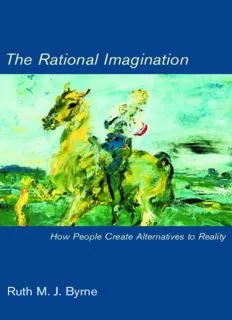
The Rational Imagination: How People Create Alternatives to Reality PDF
Preview The Rational Imagination: How People Create Alternatives to Reality
Professor Ruth M. J. Byrne is Head of the Psychology cognitive science/psychology T The Rational Imagination Department at Trinity College, Dublin University, Ireland. h How People Create Alternatives to Reality “In this lucid and beautifully written book Byrne builds a sturdy bridge between the the- e Ruth M. J. Byrne A Bradford Book ories of counterfactual thought and inferential reasoning. The integrated treatment that R she proposes is a major contribution to both fields.” The human imagination remains one of the last unchart- —Daniel Kahneman, Princeton University, Nobel Laureate in Economic Sciences (2002) a ed terrains of the mind. This accessible and original t i The Rational Imagination monograph explores a central aspect of the imagination, o “‘Knowing what I now know I would still have authorized the President to go to war.’—John the creation of counterfactual alternatives to reality, and n Kerry. If you want to understand why such conditionals matter, then you should read this claims that imaginative thoughts are guided by the same a book. It brings together an account of rationality and creativity to present a unique and principles that underlie rational thoughts. Research has l powerful theory of how we think about alternatives to reality.” shown that rational thought is more imaginative than I —Philip N. Johnson-Laird, Stuart Professor of Psychology, Princeton University m cognitive scientists had supposed; in The Rational Imagination, Ruth Byrne argues that imaginative a “This is a wonderful and brilliant book. Byrne draws connections to many aspects of cog- thought is more rational than scientists have imagined. g nition, but also to social psychology, differential psychology, evolutionary psychology, and People often create alternatives to reality and imag- i clinical psychology. The book shows great breadth of imagination at the same time that n ine how events might have turned out “if only” some- it shows rigorous attention to the details of experimental designs. This is a terrific book— a thing had been different. Byrne explores the “fault lines” I really enjoyed reading it.” t of reality, the aspects of reality that are more readily i —Robert J. Sternberg, IBM Professor of Psychology and Education, and Director of the o changed in imaginative thoughts. She finds that our ten- PACE Center, Yale University n dencies to imagine alternatives to actions, controllable events, socially unacceptable actions, causal and enabling relations, and events that come last in a tem- poral sequence provide clues to the cognitive process- es upon which the counterfactual imagination depends. The explanation of these processes, Byrne argues, rests B on the idea that imaginative thought and rational y thought have much in common. r n e How People Create Alternatives to Reality Cover art: Jack B. Yeats, The Singing Horseman,National Gallery of Ireland © 2005 Artists Rights Society (ARS), New York / DACS, London. The MIT Press Massachusetts Institute of Technology Cambridge, Massachusetts 02142 Ruth M. J. Byrne http://mitpress.mit.edu ,!7IA2G2-acfied!:t;K;k;K;k 0-262-02584-1 The Rational Imagination The Rational Imagination HowPeopleCreateAlternativestoReality RuthM.J.Byrne ABradfordBook TheMITPress Cambridge,Massachusetts London,England (2005MassachusettsInstituteofTechnology Allrightsreserved.Nopartofthisbookmaybereproducedinanyformbyanyelec- tronic or mechanical means (including photocopying, recording, or information storageandretrieval)withoutpermissioninwritingfromthepublisher. MITPressbooksmaybepurchasedatspecialquantitydiscountsforbusinessorsales promotional use. For information, please e-mail [email protected] or write to Special Sales Department, The MIT Press, 55 Hayward Street, Cambridge, MA02142. ThisbookwassetinStoneSerifandStoneSanson3B2byAscoTypesetters,Hong Kong.PrintedandboundintheUnitedStatesofAmerica. LibraryofCongressCataloging-in-PublicationData Byrne,RuthM.J. Therationalimagination:howpeoplecreatealternativestoreality/RuthM.J. Byrne. p. cm. ‘‘ABradfordbook.’’ Includesbibliographicalreferencesandindex. ISBN0-262-02584-1(alk.paper) 1.Imagination(Philosophy). 2.Reasoning. I.Title. B105.I49B97 2005 1280.3—dc22 2004063262 10 9 8 7 6 5 4 3 2 1 ForMarkKeaneandAliciaByrneKeanewithallmylove Contents Preface xi 1 TheCounterfactualImagination 1 Imagination 2 CounterfactualImagination 3 WhatPeopleImagine 5 ImaginativeThoughtsandEmotions 8 WhatPeopleDoNotImagine 9 Summary 14 2 ImaginationandRationalThought 15 RationalThought 16 TheInterpretationof‘‘If’’ 19 ConditionalsandPossibilities 20 ConditionalInferences 22 InferencesandPossibilities 25 RationalityandConditionalInferences 28 RationalThoughtandImaginativeThought 30 CounterfactualConditionals 30 Dual-PossibilityIdeas 34 TheMutabilityofDual-PossibilityConcepts 36 TheRationalityoftheCounterfactualImagination 38 Summary 40 3 ImaginingHowActionsMightHaveBeenDifferent 43 ‘‘IfOnly...’’AlternativestoActions 43 viii Contents CluesfromReasoning:CounterfactualConditionals 48 CounterfactualConditionalsandDualPossibilities 48 TheRationalImagination:WhyPeopleImagineAlternativestoActions 52 ActionsandDualPossibilities 53 FailurestoAct 54 DualPossibilitiesforInactions 57 TheInactionEffect 62 Summary 66 4 ThinkingaboutWhatShouldHaveHappened 69 PeopleSay‘‘IfOnly...’’aboutWhatShouldNotHaveHappened 69 ControllableEventsandAcceptableEvents 70 CluesfromReasoning:InferencesaboutObligations 74 ForbiddenPossibilities 74 ForbiddenPossibilitiesandInferences 76 BiconditionalObligations:TwoForbiddenPossibilities 81 CounterfactualObligations 83 TheRationalImagination:WhyPeopleFocusonForbiddenFruit 87 ImaginedAlternativestoForbiddenPossibilities 87 ImaginedAlternativesandObligations 88 ObligationsandDomain-SpecificPossibilities 92 PermissionSchemasandSocial-ContractModules 92 ForbiddenPossibilities,Permissions,andSocialContracts 95 Summary 97 5 CausalRelationsandCounterfactuals 99 TheFocusofCounterfactualandCausalThoughts 100 TheCausalChickenandtheCounterfactualEgg 102 CluesfromReasoning:StrongCausalandEnablingRelations 106 CounterfactualThoughtsandEnablingRelations 107 ThePossibilitiesforEnablingRelations 108 DifferentInterpretationsLeadtoDifferentInferences 111 HowDoPeopleDistinguishCausalandEnablingRelations? 114 EnablingRelationsandPrevention 117 Contents ix TheRationalImagination:WhyCounterfactualandCausalThoughtsDiffer 118 PeopleGenerateMoreCausalThanCounterfactualThoughts 119 WhatMakesPeopleThinkaboutaCauseorImagineanAlternative? 123 Summary 126 6 ‘‘EvenIf...’’ 129 PeopleImagineSemifactualAlternatives 130 SemifactualConditionalsandPossibilities 130 SemifactualAlternativesDenyaCausalLink 132 SemifactualAlternativesandWeakCausalRelations 135 CluesfromReasoning:‘‘EvenIf...’’ConditionalsandInferences 137 SemifactualConditionalsandInferences 138 ConditionalsasPrimes 143 TheRationalImagination:ImaginedSemifactualsandCausality 145 SemifactualAlternativesandCausality 145 TheHiddenPossibility 149 CounterfactualsAreNotBiconditionals 150 ‘‘EvenIf...’’ConditionalsandtheThirdPossibility 152 Summary 155 7 The‘‘LastChance’’ 157 PeopleFocusonRecentEvents 157 CluesfromReasoning:TheCaseof‘‘OnlyIf’’Conditionals 158 ‘‘OnlyIf’’ConditionalsandInferences 159 PossibilitiesPreserveTemporalOrder 162 TheRationalImagination:WhyPeopleChangeRecentEvents 167 AProgramtoSimulateTemporalAnchoring 169 AnchoredPossibilitiesandDualPossibilities 171 TheSpaceofCounterfactualPossibilities 175 Summary 179 8 IndividualsandCreativeThoughts 181 IndividualDifferencesinImaginativeThoughts 182 FactsandOtherPossibilities 183 MultiplePossibilities 185 HeuristicsandStrategies 189
Description: